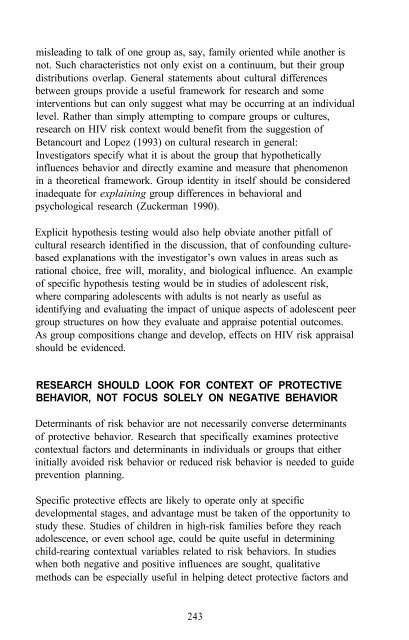The Context of HIV Risk Among Drug Users and Their Sexual Partners
The Context of HIV Risk Among Drug Users and Their Sexual Partners
The Context of HIV Risk Among Drug Users and Their Sexual Partners
You also want an ePaper? Increase the reach of your titles
YUMPU automatically turns print PDFs into web optimized ePapers that Google loves.
misleading to talk <strong>of</strong> one group as, say, family oriented while another is<br />
not. Such characteristics not only exist on a continuum, but their group<br />
distributions overlap. General statements about cultural differences<br />
between groups provide a useful framework for research <strong>and</strong> some<br />
interventions but can only suggest what may be occurring at an individual<br />
level. Rather than simply attempting to compare groups or cultures,<br />
research on <strong>HIV</strong> risk context would benefit from the suggestion <strong>of</strong><br />
Betancourt <strong>and</strong> Lopez (1993) on cultural research in general:<br />
Investigators specify what it is about the group that hypothetically<br />
influences behavior <strong>and</strong> directly examine <strong>and</strong> measure that phenomenon<br />
in a theoretical framework. Group identity in itself should be considered<br />
inadequate for explaining group differences in behavioral <strong>and</strong><br />
psychological research (Zuckerman 1990).<br />
Explicit hypothesis testing would also help obviate another pitfall <strong>of</strong><br />
cultural research identified in the discussion, that <strong>of</strong> confounding culturebased<br />
explanations with the investigator’s own values in areas such as<br />
rational choice, free will, morality, <strong>and</strong> biological influence. An example<br />
<strong>of</strong> specific hypothesis testing would be in studies <strong>of</strong> adolescent risk,<br />
where comparing adolescents with adults is not nearly as useful as<br />
identifying <strong>and</strong> evaluating the impact <strong>of</strong> unique aspects <strong>of</strong> adolescent peer<br />
group structures on how they evaluate <strong>and</strong> appraise potential outcomes.<br />
As group compositions change <strong>and</strong> develop, effects on <strong>HIV</strong> risk appraisal<br />
should be evidenced.<br />
RESEARCH SHOULD LOOK FOR CONTEXT OF PROTECTIVE<br />
BEHAVIOR, NOT FOCUS SOLELY ON NEGATIVE BEHAVIOR<br />
Determinants <strong>of</strong> risk behavior are not necessarily converse determinants<br />
<strong>of</strong> protective behavior. Research that specifically examines protective<br />
contextual factors <strong>and</strong> determinants in individuals or groups that either<br />
initially avoided risk behavior or reduced risk behavior is needed to guide<br />
prevention planning.<br />
Specific protective effects are likely to operate only at specific<br />
developmental stages, <strong>and</strong> advantage must be taken <strong>of</strong> the opportunity to<br />
study these. Studies <strong>of</strong> children in high-risk families before they reach<br />
adolescence, or even school age, could be quite useful in determining<br />
child-rearing contextual variables related to risk behaviors. In studies<br />
when both negative <strong>and</strong> positive influences are sought, qualitative<br />
methods can be especially useful in helping detect protective factors <strong>and</strong><br />
243
















